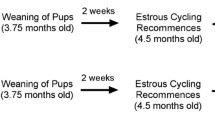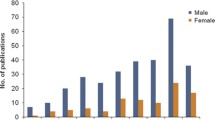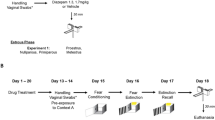Abstract
Recently, evidence has emerged showing that the behavioural and hormonal features of fear extinction are altered as a result of reproductive experience in both rats and humans. The current set of experiments sought to determine whether reproductive experience also alters the molecular features of fear extinction. In adult male rats, it has been widely demonstrated that the activation of N-methyl-d-aspartate receptors (NMDAR) is essential for fear extinction. We therefore compared the involvement of NMDAR in fear extinction between nulliparous (virgin) and primiparous (reproductively experienced) female rats. Nulliparous and primiparous females received systemic administrations of either MK-801 (a non-competitive NMDAR antagonist) or saline prior to extinction training. MK-801 was found to impair extinction recall in nulliparous females, but not primiparous females. When the same dose of MK-801 was administered prior to conditioning, both groups of rats showed impaired recall of conditioning the following day. The results of these experiments indicate that the extinction, but not the acquisition of fear, may become NMDAR-independent following reproductive experience.






Similar content being viewed by others
References
Baker JD, Azorlosa JL (1996) The NMDA antagonist MK-801 blocks the extinction of Pavlovian fear conditioning. Behav Neurosci 110:618–620
Baker KD, Richardson R (2017) Pharmacological evidence that a failure to recruit NMDA receptors contributes to impaired fear extinction retention in adolescent rats. Neurobiol Learn Mem 143:18–26. https://doi.org/10.1016/j.nlm.2016.10.014
Barha CK, Dalton GL, Galea LAM (2010) Low doses of 17 alpha-estradiol and 17 bold italic beta-estradiol facilitate, whereas higher doses of estrone and 17 alpha-and 17 bold italic beta-estradiol impair, contextual fear conditioning in adult female rats. Neuropsychopharmacology 35:547–559. https://doi.org/10.1038/npp.2009.161
Bisby MA, Baker KD, Richardson R (2018) Elucidating the mechanisms of fear extinction in developing animals: a special case of NMDA receptor-independent extinction in adolescent rats. Learn Mem 25:158–164
Bridges RS, Byrnes EM (2006) Reproductive experience reduces circulating 17β-estradiol and prolactin levels during proestrus and alters estrogen sensitivity in female rats. Endocrinol 147:2575–2582. https://doi.org/10.1210/en.2005-0917
Burgos-Robles A, Vidal-Gonzalez I, Santini E, Quirk GJ (2007) Consolidation of fear extinction requires NMDA receptor-dependent bursting in the ventromedial prefrontal cortex. Neuron 53:871–880. https://doi.org/10.1016/j.neuron.2007.02.021
Chang YJ, Yang CH, Liang YC, Yeh CM, Huang CC, Hsu KS (2009) Estrogen modulates sexually dimorphic contextual fear extinction in rats through estrogen receptor β. Hippocampus 19:1142–1150
Choi DC, Maguschak KA, Ye K, Jang S-W, Myers KM, Ressler KJ (2010) Prelimbic cortical BDNF is required for memory of learned fear but not extinction or innate fear. Proc Natl Acad Sci U S A 107:2675–2680
Fanselow MS (1980) Conditional and unconditional components of post-shock freezing. Pavlovian J Biol Sci 15:177–182
Foa EB, McLean CP (2016) The efficacy of exposure therapy for anxiety-related disorders and its underlying mechanisms: the case of OCD and PTSD. Annu Rev Clin Psychol 12:1–28
Foy M, Xu J, Xie X, Brinton R, Thompson R, Berger T (1999) 17β-estradiol enhances NMDA receptor-mediated EPSPs and long-term potentiation. J Neurophysiol 81:925–929
Francis DD, Champagne FC, Meaney MJ (2000) Variations in maternal behaviour are associated with differences in oxytocin receptor levels in the rat. J Neuroendocrinol 12:1145–1148
Graham BM, Daher M (2016) Estradiol and progesterone have opposing roles in the regulation of fear extinction in female rats. Neuropsychopharmacology 41:774–780
Graham BM, Milad MR (2011) The study of fear extinction: implications for anxiety disorders. Am J Psychiatry 168:1255–1265
Graham BM, Milad MR (2013) Blockade of estrogen by hormonal contraceptives impairs fear extinction in female rats and women. Biol Psychiatry 73:371–378
Graham BM, Scott E (2018) Effects of systemic estradiol on fear extinction in female rats are dependent on interactions between dose, estrous phase, and endogenous estradiol levels. Horm Behav 97:67–74
Gruene TM, Roberts E, Thomas V, Ronzio A, Shansky RM (2015) Sex-specific neuroanatomical correlates of fear expression in prefrontal-amygdala circuits. Biol Psychiatry 78:186–193. https://doi.org/10.1016/j.biopsych.2014.11.014
Gupta RR, Sen S, Diepenhorst LL, Rudick CN, Maren S (2001) Estrogen modulates sexually dimorphic contextual fear conditioning and hippocampal long-term potentiation (LTP) in rats. Brain Res 888:356–365. https://doi.org/10.1016/S0006-8993(00)03116-4
Hao Y, Huang W, Nielsen DA, Kosten TA (2011) Litter gender composition and sex affect maternal behavior and DNA methylation levels of the oprm1 gene in rat offspring. Front Psychiatry 2:21. https://doi.org/10.3389/fpsyt.2011.00021
Kim JH, Hamlin AS, Richardson R (2009) Fear extinction across development: the involvement of the medial prefrontal cortex as assessed by temporary inactivation and immunohistochemistry. J Neurosci 29:10802–10808. https://doi.org/10.1523/JNEUROSCI.0596-09.2009
Kim JH, Richardson R (2007a) A developmental dissociation in reinstatement of an extinguished fear response in rats. Neurobiol Learn Mem 88:48–57. https://doi.org/10.1016/j.nlm.2007.03.004
Kim JH, Richardson R (2007b) A developmental dissociation of context and GABA effects on extinguished fear in rats. Behav Neurosci 121:131–139. https://doi.org/10.1037/0735-7044.121.1.131
Kim JH, Richardson R (2010) Extinction in preweanling rats does not involve NMDA receptors. Neurobiol Learn Mem 94:176–182. https://doi.org/10.1016/j.nlm.2010.05.004
Kinsley CH, Madonia L, Gifford GW, Tureski K, Griffin GR, Lowry C, Williams J, Collins J, McLearie H, Lambert KG (1999) Motherhood improves learning and memory. Nature 402:137–138. https://doi.org/10.1038/45957
Kinsley CH, Trainer R, Stafisso-Sandoz G, Quadros P, Marcus LK, Hearon C, Meyer EA, Hester N, Morgan M, Kozub FJ, Lambert KG (2006) Motherhood and the hormones of pregnancy modify concentrations of hippocampal neuronal dendritic spines. Horm Behav 49:131–142. https://doi.org/10.1016/j.yhbeh.2005.05.017
Langton JM, Kim JH, Nicholas J, Richardson R (2007) The effect of the NMDA receptor antagonist MK-801 on the acquisition and extinction of learned fear in the developing rat. Learn Mem 14:665–668. https://doi.org/10.1101/lm.692407
Langton JM, Richardson R (2009) The role of context in the re-extinction of learned fear. Neurobiol Learn Mem 92:496–503
Laurent V, Marchand AR, Westbrook RF (2008) The basolateral amygdala is necessary for learning but not relearning extinction of context conditioned fear. Learn Mem 15:304–314. https://doi.org/10.1101/lm.928208
Ledgerwood L, Richardson R, Cranney J (2003) Effects of D-cycloserine on extinction of conditioned freezing. Behav Neurosci 117:341–349. https://doi.org/10.1037/0735-7044.117.2.341
Lemaire V, Billard JM, Dutar P, George O, Piazza PV, Epelbaum J, le Moal M, Mayo W (2006) Motherhood-induced memory improvement persists across lifespan in rats but is abolished by a gestational stress. Eur J Neurosci 23:3368–3374. https://doi.org/10.1111/j.1460-9568.2006.04870.x
Leuner B, Glasper ER, Gould E (2010) Parenting and plasticity. Trends Neurosci 33:465–473. https://doi.org/10.1016/j.tins.2010.07.003
Leuner B, Gould E (2010) Dendritic growth in medial prefrontal cortex and cognitive flexibility are enhanced during the postpartum period. J Neurosci 30:13499–13503. https://doi.org/10.1523/JNEUROSCI.3388-10.2010
Leuner B, Shors TJ (2006) Learning during motherhood: a resistance to stress. Horm Behav 50:38–51. https://doi.org/10.1016/j.yhbeh.2006.01.002
Lewis MC, Gould TJ (2004) Latent inhibition of cued fear conditioning: an NMDA receptor-dependent process that can be established in the presence of anisomycin. Eur J Neurosci 20:818–826
Lewis MC, Kerr KM, Orr PT, Frick KM (2008) Estradiol-induced enhancement of object memory consolidation involves NMDA receptors and protein kinase A in the dorsal hippocampus of female C57BL/6 mice. Behav Neurosci 122:716–721. https://doi.org/10.1037/0735-7044.122.3.716
Li S, Graham BM (2016) Estradiol is associated with altered cognitive and physiological responses during fear conditioning and extinction in healthy and spider phobic women. Behav Neurosci 130:614–623. https://doi.org/10.1037/bne0000166
Li SH, Graham BM (2017) Why are women so vulnerable to anxiety, trauma-related and stress-related disorders? The potential role of sex hormones. Lancet Psychiatry 4:73–82. https://doi.org/10.1016/S2215-0366(16)30358-3
Liu IYC, Lyons WE, Mamounas LA, Thompson RF (2004) Brain-derived neurotrophic factor plays a critical role in contextual fear conditioning J Neurosci 24:7958–7963. doi: https://doi.org/10.1037/h0042199
Liu JL, Li M, Dang XR, Wang ZH, Rao ZR, Wu SX, Li YQ, Wang W (2009) A NMDA receptor antagonist, MK-801 impairs consolidating extinction of auditory conditioned fear responses in a Pavlovian model. PLoS One 4:e7548. https://doi.org/10.1371/journal.pone.0007548
Love G, Torrey N, McNamara I, Morgan M, Banks M, Hester NW, Glasper ER, DeVries AC, Kinsley CH, Lambert KG (2005) Maternal experience produces long-lasting behavioral modifications in the rat. Behav Neurosci 119:1084–1096. https://doi.org/10.1037/0735-7044.119.4.1084
Lubow RE (1973) Latent inhibition. Psychol Bull 79:398–407
Macbeth AH, Scharfman HE, MacLusky NJ, Gautreaux C, Luine VN (2008) Effects of multiparity on recognition memory, monoaminergic neurotransmitters, and brain-derived neurotrophic factor (BDNF). Horm Behav 54:7–17
Makkar SR, Zhang SQ, Cranney J (2010) Behavioral and neural analysis of GABA in the acquisition, consolidation, reconsolidation, and extinction of fear memory. Neuropsychopharmacology 35:1625–1652
Markus EJ, Zecevic M (1997) Sex differences and estrous cycle changes in hippocampus-dependent fear conditioning. Psychobiol 25:246–252
McLean CP, Asnaani A, Litz BT, Hofmann SG (2011) Gender differences in anxiety disorders: prevalence, course of illness, comorbidity and burden of illness. J Psychiatr Res 45:1027–1035
Milad MR, Igoe SA, Lebron-Milad K, Novales JE (2009) Estrous cycle phase and gonadal hormones influence conditioned fear extinction. Neuroscience 164:887–895. https://doi.org/10.1016/j.neuroscience.2009.09.011
Milad MR, Zeidan MA, Contero A, Pitman RK, Klibanski A, Rauch SL, Goldstein JM (2010) The influence of gonadal hormones on conditioned fear extinction in healthy humans. Neuroscience 168:652–658
Milligan-Saville JS, Graham BG (2016) Mothers do it differently: reproductive experience alters fear extinction in female rats and women. Transl Psychiatry 6:e928
Monte LM, Ellis RR (2014) Fertility of women in the United States: 2012. Econ 24:1071–1100
Myers KM, Davis M (2004) AX+, BX-discrimination learning in the fear-potentiated startle paradigm: possible relevance to inhibitory fear learning in extinction. Learn Mem 11:464–475
Myers KM, Davis M (2007) Mechanisms of fear extinction. Mol Psychiatry 12:120–150
Paris JJ, Frye CA (2008) Estrous cycle, pregnancy, and parity enhance performance of rats in object recognition or object placement tasks. Reproduction 136:105–115. https://doi.org/10.1530/REP-07-0512
Pawluski JL, Galea LA (2006) Hippocampal morphology is differentially affected by reproductive experience in the mother. J Neurobiol 66:71–81. https://doi.org/10.1002/neu.20194
Pawluski JL, Vanderbyl BL, Ragan K, Galea LA (2006) First reproductive experience persistently affects spatial reference and working memory in the mother and these effects are not due to pregnancy or ‘mothering’ alone. Behav Brain Res 175:157–165. https://doi.org/10.1016/j.bbr.2006.08.017
Phillips R, LeDoux J (1992) Differential contribution of amygdala and hippocampus to cued and contextual fear conditioning. Behav Neurosci 106:274–285
Pineles SL, Nillni YI, King MW, Patton SC, Bauer MR, Mostoufi SM, Gerber MR, Hauger R, Resick PA, Rasmusson AM, Orr SP (2016) Extinction retention and the menstrual cycle: different associations for women with posttraumatic stress disorder. J Abnorm Psychol 125:349–355
Quirk GJ, Mueller D (2008) Neural mechanisms of extinction learning and retrieval. Neuropsychopharmacology 33:56–72
Rasia-Filho AA, Fabian C, Rigoti KM, Achaval M (2004) Influence of sex, estrous cycle and motherhood on dendritic spine density in the rat medial amygdala revealed by the Golgi method. Neuroscience 126:839–847. https://doi.org/10.1016/j.neuroscience.2004.04.009
Raybuck JD, Lattal KM (2011) Double dissociation of amygdala and hippocampal contributions to trace and delay fear conditioning. PLoS One 6:e15982
Rey CD, Lipps J, Shansky RM (2014) Dopamine d1 receptor activation rescues extinction impairments in low-estrogen female rats and induces cortical layer-specific activation changes in prefrontal–amygdala circuits. Neuropsychopharmacology 39:1282–1289
Rosas-Vidal LE, Do-Monte FH, Sotres-Bayon F, Quirk GJ (2014) Hippocampal–prefrontal BDNF and memory for fear extinction. Neuropsychopharmacology 39:2161–2169
Ross LE, McLean LM (2006) Anxiety disorders during pregnancy and the postpartum period: a systematic review. J Clin Psychiatry 67:1285–1298
Schauz C, Koch M (2000) Blockade of NMDA receptors in the amygdala prevents latent inhibition of fear-conditioning. Learn Mem 7:393–399
Singewald N, Schmuckermair C, Whittle N, Holmes A, Ressler K (2015) Pharmacology of cognitive enhancers for exposure-based therapy of fear, anxiety and trauma-related disorders. Pharmacol Ther 149:150–190
Smith CC, McMahon LL (2005) Estrogen-induced increase in the magnitude of long-term potentiation occurs only when the ratio of NMDA transmission to AMPA transmission is increased. J Neurosci 25:7780–7791. https://doi.org/10.1523/JNEUROSCI.0762-05.2005
Sotres-Bayon F, Bush DE, LeDoux JE (2007) Acquisition of fear extinction requires activation of NR2B-containing NMDA receptors in the lateral amygdala. Neuropsychopharmacology 32:1929–1940. https://doi.org/10.1038/sj.npp.1301316
Traverso LM, Ruiz G, De la Casa LG (2012) Effect of the NMDA antagonist MK-801 on latent inhibition of fear conditioning. Pharmacol Biochem Behav 102:488–494. https://doi.org/10.1016/j.pbb.2012.06.014
Walker DL, Ressler KJ, Lu K-T, Davis M (2002) Facilitation of conditioned fear extinction by systemic administration or intra-amygdala infusions of D-cycloserine as assessed with fear-potentiated startle in rats. J Neurosci 22:2343–2351
Wegerer M, Kerschbaum H, Blechert J, Wilhelm FH (2014) Low levels of estradiol are associated with elevated conditioned responding during fear extinction and with intrusive memories in daily life. Neurobiol Learn Mem 116:145–154
White EC, Graham BM (2016) Estradiol levels in women predict skin conductance response but not valence and expectancy ratings in conditioned fear extinction. Neurobiol Learn Mem 134:339–348
Woolley CS, Weiland NG, McEwen BS, Schwartzkroin PA (1997) Estradiol increases the sensitivity of hippocampal CA1 pyramidal cells to NMDA receptor-mediated synaptic input: correlation with dendritic spine density. J Neurosci 17:1848–1859
Workman JL, Barha CK, Galea LAM (2012) Endocrine substrates of cognitive and affective changes during pregnancy and postpartum. Behav Neurosci 126:54–72
Zeidan MA, Igoe SA, Linnman C, Vitalo A, Levine JB, Klibanski A, Goldstein JM, Milad MR (2011) Estradiol modulates medial prefrontal cortex and amygdala activity during fear extinction in women and female rats. Biol Psychiatry 70:920–927
Funding
This work was supported by grants from the Australian Research Council (DE140100243 and DP180101563) to BMG and an Australian Postgraduate Award to ST.
Author information
Authors and Affiliations
Corresponding author
Ethics declarations
All rats were treated according to The Australian Code of Practice for the Care and Use of Animals for Scientific Purposes (8th edition), and all procedures were approved by the Animal Care and Ethics Committee at The University of New South Wales.
Conflicts of interest
The authors declare that they have no conflict of interest.
Additional information
This article belongs to a Special Issue on Psychopharmacology of Extinction.
Rights and permissions
About this article
Cite this article
Tang, S., Graham, B.M. Reproductive experience alters the involvement of N-methyl-D-aspartate receptors in fear extinction, but not fear conditioning, in female Sprague Dawley rats. Psychopharmacology 236, 251–264 (2019). https://doi.org/10.1007/s00213-018-4956-y
Received:
Accepted:
Published:
Issue Date:
DOI: https://doi.org/10.1007/s00213-018-4956-y




